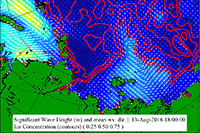
|
|
2016 Arctic Cyclone Wave - Ice Interactions |
||
Caption:
The animation shows the significant wave height (in meters, indicated by color scale) during the 2016 Arctic cyclone, as predicted by a numerical wave model run at the NRL 7322. The solid red lines correspond to the analysis ice concentrations (25%, 50%, and 75%) used as input for the wave model. White arrows indicate wave direction. [The region shown is a portion of Arctic Ocean north of Siberia]
Discussion of graphics:
The model used here is a development version of the open source community wave model WAVEWATCH III (WW3 Dev. Group 2016). This code was written originally at the National Weather Service (NWS); since 2008, continued development is by multiple agencies, including NWS, NRL, Ifremer (France), and others. This hindcast uses two time-varying inputs: 10-meter wind vectors from the atmospheric model NAVGEM (Navy Global Environmental Model, Hogan et al. 2014) run at the Fleet Numerical Meteorology and Oceanography Center (FNMOC), and analyses of ice concentrations (also produced at FNMOC) from passive microwave radiometer (SSM/I). The wave model is run on a polar stereographic grid with resolution of approximately 18 km.
The maximum wave height predicted here is 5.9 meters, occurring during the early part of the cyclone (1800 UTC August 14), in the eastern Kara Sea. Perhaps of more interest are the waves further east, in the Arctic Ocean proper, north of the New Siberian Islands, where wave height estimates are as high as 4.3 meters late on August 15 (UTC). In this case, the waves are directly incident on the ice edge. This, of course can lead to fracturing of the ice (e.g. Collins et al. 2015), and increased lateral melt. It has also been postulated that wave induced mixing (associated with so-called Stokes shear) can bring up warm water to accelerate melting after a wave event. (This is one topic studied during the 6-week field campaign of the Office of Naval Research "Sea State" Program during autumn 2015: http://www.apl.washington.edu/project/project.php?id=arctic_sea_state)
We notice in the animation that there is a moderate retreat of the ice edge toward the east in the SSM/I analysis following the 4.3 meter waves on the 15th. We have not yet established a causal relation between the wave event and the ice retreat for this case (e.g. there may be increased radiative heat fluxes contemporary with the wave event), but these scenarios are not uncommon, and such a connection may be regarded as a strong hypothesis.
Large waves are common at high latitudes, e.g. 10 m wave height is not unusual for the Nordic Seas and 15 m is not unusual in the Southern Ocean. However, they are a relatively new feature of the western Arctic. In a gross sense, the height to which waves grow in the real ocean is determined by surface wind speed, plus the fetch and duration of a wind event. Typically, fetch is controlled by the shoreline or size of a wind event, but in the Arctic, it is further restricted by the sea ice. In the latter half of the 20th Century, 4 to 6 meter waves in the western Arctic occurred rarely, if ever. With declining ice cover, this appears to be the "new normal" for seasonal high values, e.g. 8 m in 2006 (hindcast by Thomson et al. 2016), 4.7 m measured in 2012 (reported by Thomson and Rogers 2014) and 4.5 to 5 m measured in 2015 (Sea State cruise, see report in UW address above, and also Rogers et al. 2016).
References
Collins, C. O., W. E. Rogers, A. Marchenko and A. V. Babanin, 2015: In situ measurements of an energetic wave event in the Arctic marginal ice zone Geophysical Research Letters 42, doi:10.1002/2015GL063063
Hogan, T., and 16 Coauthors, 2014: The Navy Global Environmental Model, Oceanography, 27(3), 116-125.
Rogers, W. E., J. Thomson, H. H. Shen, M. J. Doble, P. Wadhams, and S. Cheng, 2016: Dissipation of wind waves by pancake and frazil ice in the autumn Beaufort Sea, J. Geophys. Res. Oceans, 121, doi:10.1002/2016JC012251.
Thomson, J., and W. E. Rogers, 2014: Swell and sea in the emerging Arctic Ocean, Geophys. Res. Lett., 41, doi:10.1002/2014GL059983.
Thomson, J. and 21 Coauthors, 2016: Emerging trends in the sea state of the Beaufort and Chukchi seas, Ocean Modelling 105 doi:10.1016/j.ocemod.2016.02.009
The WAVEWATCH III Development Group, 2016: User manual and system documentation of WAVEWATCH III version 5.16. Tech. Note 329, NOAA/NWS/NCEP/MMAB, College Park, MD, USA, 326 pp. + Appendices.
 Click here for Animation of 2016 Arcitic Cyclone
Click here for Animation of 2016 Arcitic Cyclone